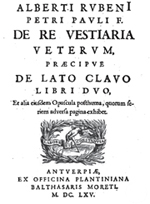

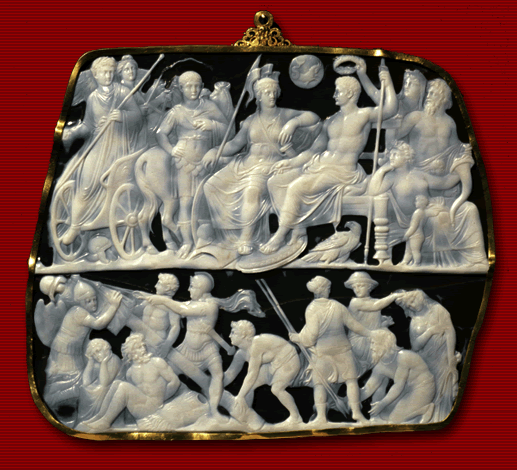
Gemma Augustea (fragment)
photo: © Kunsthistorisches Museum, Vienna
Inv. Nr. ANSA IX a79
The ‘Gemma Augustea’
The ‘Gemma Augustea’, originally owned by the Imperial family, was probably brought to Toulouse after the crusader conquest of Constantinople in 1204. The ‘Gemma Augustea’ is listed in the 1246 inventory of the treasury of the church Saint Sernin in Toulouse, where it remained until 1533. It passed into the possession of King Francis I of France and was brought to Vienna by Emperor Rudolf II in 1619, bought for 12.000 Ducats, and set in a new mount with a slim gold rim. Today the cameo is in the Kunsthistorisches Museum, Vienna.
The older mount, which is described in an inventory of August 11, 1489, is unfortunately lost. (A)
The piece was probably commissioned in the aftermath of Varus’ defeat by Germanic tribesmen in the Teutoburg forest in September 9 AD: three legions with their commanders, officers and auxiliary troupes were completely annihilated - an event that destabilized the empire considerably. News of the defeat prompted Augustus to station guards throughout Rome to prevent civil unrest (1).
The Gemma Augustea is classified as ‘Staatskameo’, a term coined by German archaeologists for the small group of exquisite cameos carved with depictions of the emperor, subjects iconographically related to him and the wider imperial family. The creation of the cameo falls into a historical period in which Augustus had adopted his step-son Tiberius (in 4 AD). Tiberius was made to adopt the son of the older Drusus, Germanicus, in spite of already having a son of his own, Drusus Minor.
Collective action, peace and cohesion in all parts of the empire and the continuation of the dynasty which was secured by the adoption of 4 AD was the important message the Gemma Augustea ,with its many characters, should convey.
Emperor Augustus’ plans to secure the imperial line thus already spanned two generations.
Tiberius was co-regent, and Augustus left no room for doubt that the Empire would pass into safe hands after his death. Both regents are shown with sceptres on the cameo: to emphasize their equality in rank.
From 6 AD onwards Tiberius was leading the war against the Panonnian uprising. Victory came in 9 AD, and this is depicted in two upper registers. Tiberius (42 BC – 37 AD) returns victorious from Pannonia-Dalmatia, not in a triumphal procession in a quadriga with eagle sceptre and laurel wreath – an occasion postponed by him on receiving the new of the defeat of Varus – but in a biga, a two horse chariot(2). He is the protégé of a winged Victory, who, as his charioteer, is impatiently wielding her whip and glancing backwards, and guiding Tiberius personally from victory to victory.
This is signifying the approach of a new departure. The returning Tiberius, shown dismounting from his chariot is already tasked with new challenges, new wars and victories. In the same year he left Rome again to face the Germanic tribes, together with Germanicus.
Germanicus (15 BC – 19 AD), a youth with the first fluff of a beard, is shown in front of his horse, next to Roma, his gaze turned towards the emperor. Already a veteran in the war against Pannonia, he is wearing the commander’s sash and the paludamentum on his cuirass. His left hand rests on the hilt of his sword and the right on his hip.
Tetradrachm
King of Macedonia, Alexander III ‘the Great’. 336-323 BC
inscription: BASILEOS ALEXANDROU
Photo: © CNG
It is apparent that this coin was the inspiration behind the portrait of Augustus on the Gemma Augustea: depicted is the seated Zeus with eagle, sceptre and the Macedonian star: a stylized star or sun with eight rays. (2a) In particular the throne with the high back and the turned legs seems a prototype of the bench shown on the gem.
A Roman emperor usually sits on a sella, a stool, or a bisellium, a larger seat, also backless, suitable for two persons.
A bench with a high back and turned legs, as seen on the Gemma Augustea, can therefore only be based on depictions of rulers in the east.
Seated woman playing a kithara: From Room H of the
Villa of P. Fannius Synistor at Boscoreale.
Ca. 40–30 BC.
This wall painting, an excellent copy of Hellenistic art, shows probably a Macedonian queen or princess playing a gilded kithara. She sits, as the ruler of the Macedonian coin, on the same ornately carved bench.
Similarities in composition between this painting and the Gemma Augustea are obvious. It shows how much the artists of the Roman Empire were under the influence of Hellenistic art.
Tetradrachm circa 500 BC
Ouadriga with a floating globe (Sphaera)
Macedonia -Thrace
Foto: © CNG
Augustus (63 BC– 14 AD), first emperor of the Roman Empire, and Dea Roma are sitting to the right of the centre on a bench-like throne with turned legs. The emperor is shown in the pose of Jupiter, in his raised left hand he holds the sceptre, in his right the lituus, the curved staff of the augur, symbol of the highest religious and political rank. Dea Roma, the city goddess and protectress of Rome wears a belted, sleeveless chiton. She is armed with shield, spear, sword and an Attic helmet with three crests — modelled on the Athena Parthenos by Phidias. Her left hand rests on the hilt of the sword, and thus signifies that Rome is always ready for war. Her feet, on which she wears sandals, rest on two shields placed on the floor, which are substitutes for the footstool. Beneath the throne perches an eagle, symbol of Empire and Jupiter, turned towards the approaching figures. In the field between the heads of Roma and Augustus, slightly elevated, is the Sphaera, a globe with a star and Augustus’ star sign, together with the Capricorn. This signifies the whole world, incorporating the celestial sphere: again a symbol of the world-encompassing rule, which appears again on the Grand Camée about ca. 16 years later.
Throughout his life Augustus had placed great importance and trust in his star sign. The Capricorn with an eight pointed star, which appears already early on the programmatical coinage of Octavian, recall that Augustus was chosen by the stars for the benefit and prosperity of the state.Octavian was born on September 23rd under the sign of Libra. However, the Capricornus is to be equated with the zodiac sign Capricorn. There is as yet no explanation for this discrepancy. Perhaps the Capricornus is to be interpreted as the zodiac sign under which the later Prinzeps was conceived.
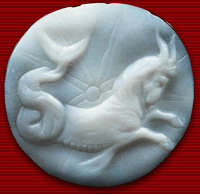
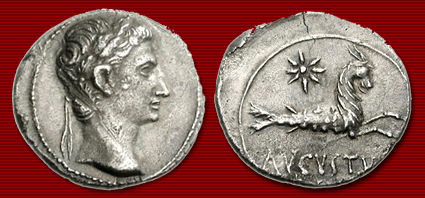
On the front right and leaning on the throne is Tellus Italiae, the Roman earth goddess, also known as Terra mater (mother earth). She is a voluptuous sprawling presence with ivy wreath and empty cornucopia on a rock. On a necklace she is wearing a drop pendant. She is accompanied by two boys, one holding two ears of corn in his lowered left hand – promise of fertility – the other is making an apotropaic gesture with his outstretched left hand. Behind the throne Oikumene, with veil and mural crown, personification of the inhabited earth (Imperium Romanum), crowns the emperor with the corona civica, an oak wreath she holds above his head. With her is the bearded muscular Oceanus, the personification of the world-ocean, encompassing everything, including the furthest northern coast to which the legions of legions of Augustus had penetrated. All three are idealized figures, symbolizing the extent of the Imperium.
The lower register, in contrast to the stately calm of the upper register, is permeated with lively movement and depicts Roman victories over foreign people. These are probably Pannonians, perhaps Celts or Germanic tribes. Roman soldiers in full armour and assistants in lighter clothes can be seen erecting a tropaion, a monument consisting of the arms taken from the conquered enemy, represented by figures cowering on the ground.
Two of the captured soldiers are dragged by their hair from the right, one wears a torque, a rigid neck ring. Intermixed with the group of Roman soldiers seem to be divine assistants. A reminder that war also involves major sacrifices for the victors is symbolized by the cuirass of a Roman officer shown laying on the ground.

The programmatic message, the promise of victory, return to order and Octavian’s closeness to divinity known also from Augustan coinage, is here extended with a discreet acknowledgment of the casualties incurred - a first. The loss of Quintilius Varus’ three legions at the hands of Germanic tribesmen must indeed have been a traumatic experience for Augustus.
The work on the Gemma Augustea probably started not long after the return of Tiberius, on January 16th in 10 AD. It is possible, however, that by this time it had already been under way. A later date is not probable, because after the victories over Pannonia and Dalmatia in October 12 AD a reference to the subdued reception of Tiberius in the direct aftermath of Varus’ defeat (biga instead of triumphal chariot) would not have been logical.
The cameo is not signed. Dioskurides has often been named as engraver of the piece. However, chronological reasons make this attribution impossible. Dioskurides is known to have worked in his native Cilicia under the last of the Seleucids, Philip II. Philorhomaios (in the 60ies BC), and thus was born around 80 BC at the latest. That he was still actively pursuing his craft at the age of 90 is improbable, and his son Hyllos seems a more probable attribution (3) . Where the workshop in which the stone was engraved was situated is unknown.
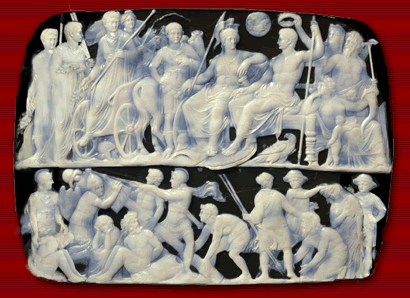
The magnificent cameo, in its present state of preservation 19 x 23cm, is unfortunately damaged and used to be much wider. At the upper left corner a big piece is missing and also on the right are numerous breaks, which have been recut and repolished to achieve a more pleasing shape. For the sake of the new composition the left arm of Oikumene and the attribute in the hand of Oceanus has been removed. This also led to the truncation of the cloak, draped over the lower arm of Oceanus.
It is unthinkable that in the original conception of the piece Oikumene was only shown with one hand while all other protagonists on the upper register are shown with two.
_____
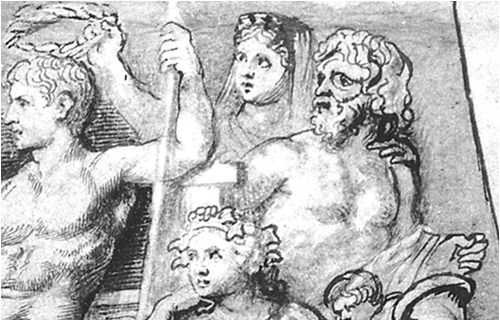
How much the missing hand of Oikumene disturbs the scene for the knowledgeable viewer becomes also apparent on the drawing by Peter Paul Rubens, from about 1621. On his drawing, created after a plastercast, the left hand of Oikumene is shown. Rubens added it without taking account of the missing attribute of Oceanus and lets the hand rest on his shoulder.
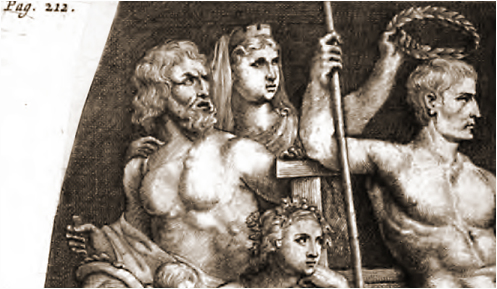
The engraving (in mirror image) after the drawing of Peter Paul Rubens.
The engraving differs from the drawing. An attribute has been added to the hand of Oceanus.
______
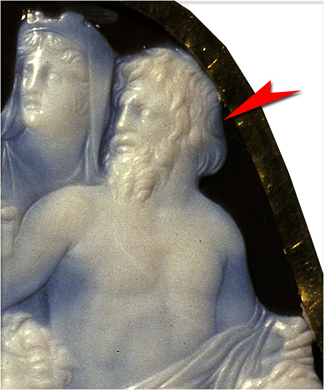
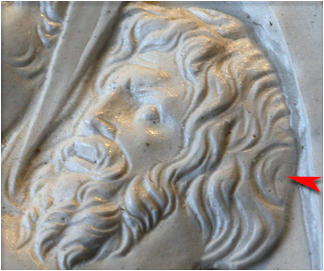
The circular incision in the hair of Oceanus.
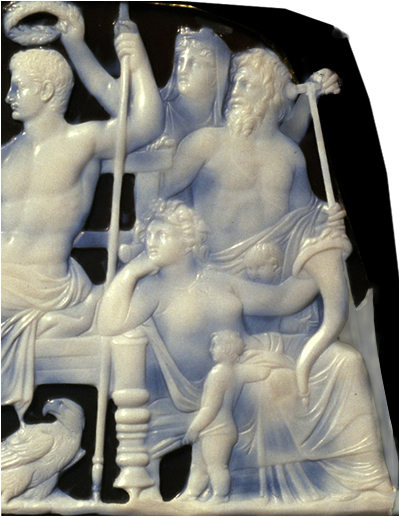
(Photographic reconstruction)
Oceanus with rudder, on which Oikumene places her left hand.
It is also possible that Oceanus held the rudder with the blade pointing up.
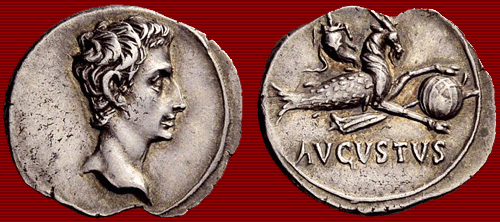
_____
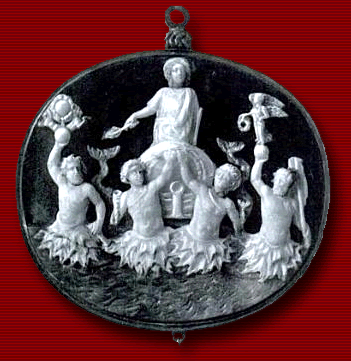
Actium-cameo (reworked)
after 27 BC
Kunsthistorisches Museum, Vienna
Inv. No. IX a 56
Originally probably Octavia as victor on a chariot drawn by tritons. The mermen are holding rudder, orb, victory with oak wreath and shield (clipeus virtutis) with capricorns. (3b)
____

Oceanus with rudder next to Tellus with cornucopia.
Sarcophagus
2. Half 3rd cent. BC
Via Casilina, Torraccia.
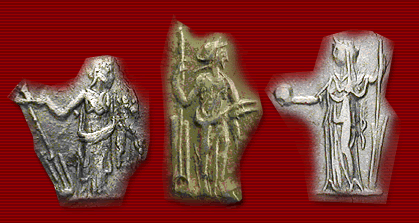
Fortuna with rudder
When the attribute was removed parts of the cornucopia were cut off. Deep incisions are clearly visible on the cast above the hand of Oceanus.
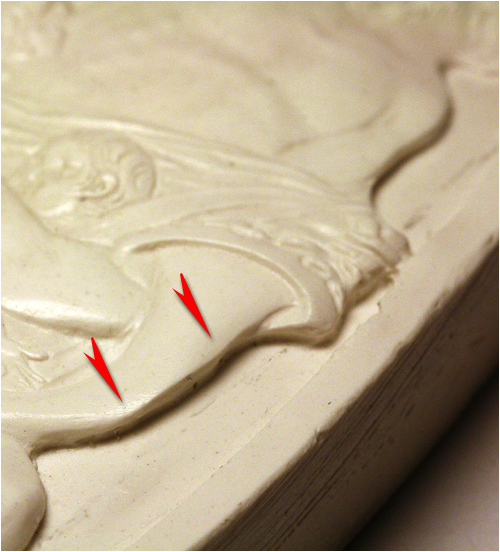
The cropped cornucopia.
______
The original shape of the Gemma Augustea was probably a symmetrical obtuse oval, a similar shape to the better preserved Gemma Claudia. The fragmentary condition of the cameo does not become apparent immediately to most viewers: the preserved stone appears coherent and well structured on first sight. It soon emerges that the square, asymmetric shape is not in accord with the once harmonious depiction. Between the spokes of the left wheel fragments of drapery are visible. There stood a male figure, the right hand is still visible and also the right foot at the top left. However, there must have been two figures to sufficiently counterbalance the group of three on the right. The vertical centre (axis of symmetry) of the piece thus lies between Germanicus and Roma. Augustus as the reigning emperor and his son and heir Tiberius were consciously placed equidistant to the sides, to emphasize the equal rank of the two protagonists. (see reconstruction Helmut Prückner)
Drawings of reconstructions by Simon, Scherrer and Prückner, with a plethora of suggestions for reconstructions, have not reached a satisfying result. The missing left arm of Oikumene and the missing attribute of Oceanus have not been taken into account at all. (4)

Rekonstruction E.Simon, M. Boss
1988
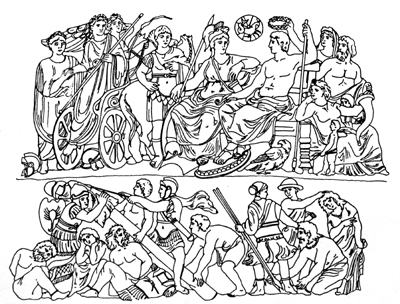
iunctio dextrarum
Rekonstruction M.Scherrer, U. Outschar
1988
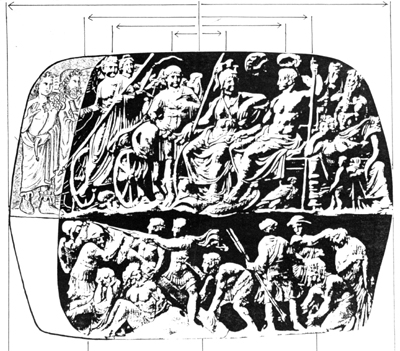
Rekonstruction H. Prückner,
Genius Senatus and Genius Populi Romani have been added in this reconstruction.
1997
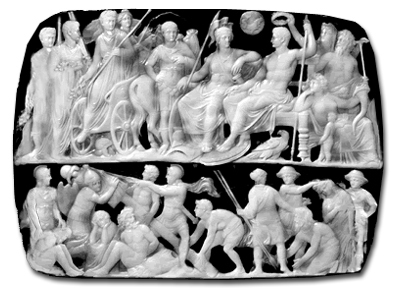
Rekonstruction G.Schmidt
2010
On the left side of the lower register fragments of a seated barbarian can be seen, only hair and a foot have been preserved. On the pelta decorated with a scorpion, hanging from the tropaion, signs of reworking are visible. The fine incised line surrounding the shield, visible above and on the right, has vanished on the left side. This indicates that another figure must have stood to the left of the shield, which probably had slight contact with the shield.
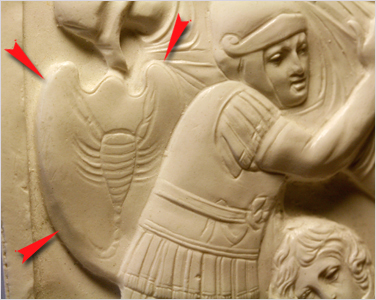
Assuming a symmetrical design, another figure must be expected next to the woman pulled by her hair. The extensive free space in this area and the traces of reworking substantiate this. She holds a cloak with both hands, middle and index finger extended in an apotropaic gesture, which has been cut off near the left hand. What kind of figures were cropped – soldiers or enemies – is impossible to guess.
The figure standing behind the captives was removed. The crack running through the stone diagonally probably damaged the head of this person substantially.
The sharp incisions on the left arm, shoulder and hair of the captive woman are clearly visible. The strands of her tousled hair have been broken, the tips of her locks cut.
Four figures have their heads removed from their bodies by the horizontal crack running exactly through their throats. Fortunately the heads remained largely unaffected by this. The figure on the right, however, had the crack running through the head (red circle) and the resulting damage must have been considered so severe that in reworking the figure was removed completely.
_______
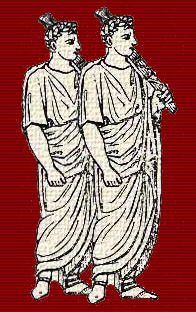
Lictors
The upper register gives some indications to help us deduce which circle the group of figures might have belonged to. Two figures must have stood next to Tiberius, at least one of them must have held a staff.
This conclusion becomes evident if we take into account the staffs reaching all the way to the edge, held by Tiberius, Roma, Augustus and Oceanus. The tilt of these are defining for the optical stability of the composition.
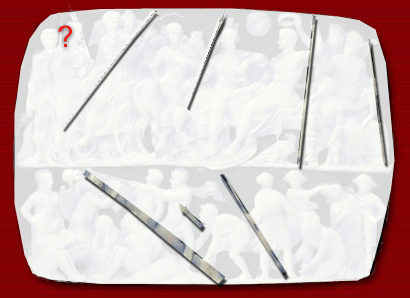
The placing of attributes
On the right side of the engraving Augustus is in the centre of idealised figures and divinities. Therefore it seems probable that the left hand side was reserved for reality, the military and the special force of bodyguards. Hans Möbius’ suggestion that Tiberius is dismounting from the chariot between his two sons, the adoptive son Germanicus and his biological son Drusus Minor, is not plausible. When Augustus adopted Tiberius he insisted that Tiberius should adopt Germanicus and thus determined his successor. (4a) It is therefore very improbable, if the cameo was created during the life of Augustus, that both sons of Tiberius were represented on the cameo.
H. Prückner’s suggestion to restore the missing figures as Genius Senatus and Genius Populi Romani is equally unsatisfying since the people and the senate are already represented in the figure of Roma.
Lictors could be imagined at this point. As a symbol of the power vested in the holder of the public office they carried rods with axes, the so-called fasces, over their left shoulder. In a triumphal procession the lictors were marching in their crimson cloaks, the paludamenta, in front of the triumphal victor, fasces wreathed in laurel and wearing laurel themselves. (5)
Since the scene on the Gemma Augustea was not a triumphal procession lictors were probably wearing toga and tunica. The reliefs with the procession on the Ara Pacis might have served as model – similarities with the Gemma Augustea can also be seen in the composition of figures.
Two lictors, accompanying the wagon in the background and holding fasces and laurel tilted to the left, would balance the composition.
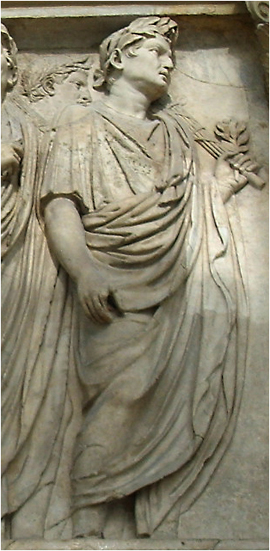
Lictor
Ara Pacis
Silver cup from the Villa Pisanella in Boscoreale.
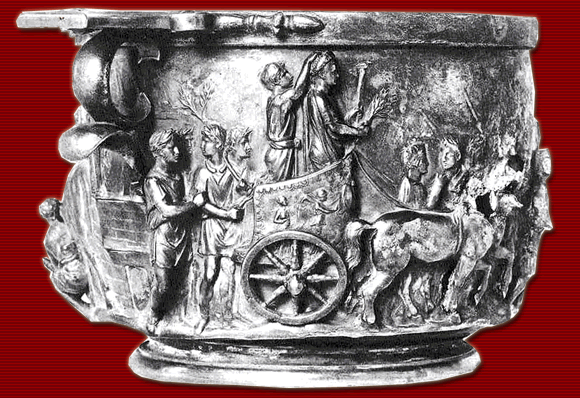
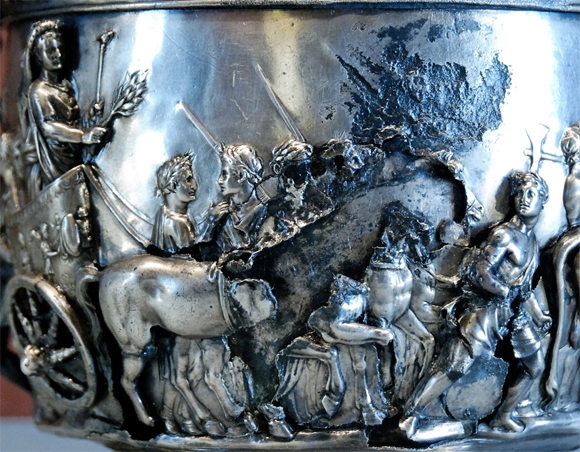
Triumphal procession of Tiberius, ca. 12 AD?
Foto: © Marie-Lan Nguyen
The cup (previously Rothschild collection), damaged heavily in WW2 and long believed lost, shows the victorious general with sceptre and laurel wreath in the triumphal chariot.
Behind him stands the imperial slave whose task was to hold the golden wreath over his head. Wreathed young men in tunics are following the chariot. The figure with the open torque, a rigid neck ring, carries laurel twigs (an officer of the auxiliary troops?). Other men are shown together with two lictors next to the chariot drawn by four horses.
____________
Of the figure of the togatus, damaged by the break and partially ground down, only his feet, parts of the drapery and fingers remain partially visible. The frequently mentioned hypothesis that the fingers were clasped around the wrist to aid the dismounting Tiberius is evidently wrong. It is unthinkable that the young, dynamic heir to the throne would need help to descend from the chariot. The suggestion of a iunctio dextrarum can also be discounted: no eye contact is made and, in addition to this, there is and never was a second hand in the area.
Such a confusion of hands would sit strangely in the clarity and simplicity of form and gestures displayed in the rest of the composition.
Rubens was dissatisfied with the lower arm of Tiberius, seemingly ending in nothing, seen on the stone. In his drawing of the Gemma Augustea from around 1621 he added a hand and ignored the one which was already there.
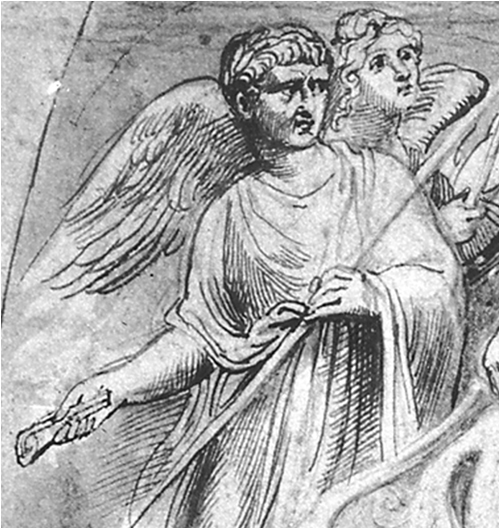
Drawing of the Gemma Augustea by Peter Paul Rubens ca. 1621 (detail)
St. Annen-Museum, Lübeck
Not so the engraving of the Gemma Augustea by Kohl, which was modelled
on meticulous drawing by Kibler.
Published in 1788 in Vienna by Joseph Edlen von Kurzbek, Joseph Hilarius Eckhel’s ‘Choix des pierres gravées du cabinet impérial des antiques...’ shows only what can be seen – contrary to Rubens beautifying rendition of the cameo drawing: the closed hand, holding an unknown object, of the figure standing next to Tiberius and the unnatural flow of the drapery around the. The folds of the tunica sleeve and the folds of the toga are merging with each other and can not be original.
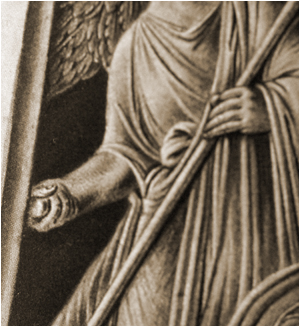
Drawing of the Gemma Augustea by Kibler (detail)
______
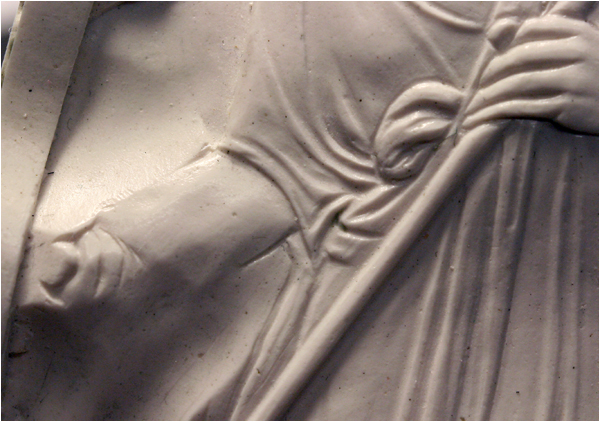
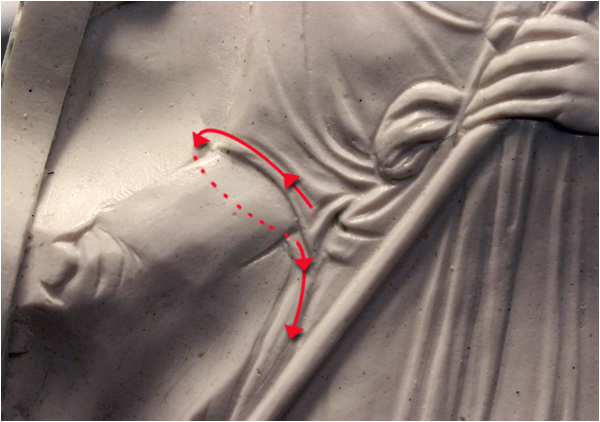
The folds of the tunica sleeve and the folds of the toga are merging with each other.
Revisions in this area are therefore obviously.
We now have to question what the original composition in the area was – before it was defaced in the recutting. The answer is not too difficult if we consider that no-one is mounting a chariot with a bent arm, such as Tiberius seems to be shown to do here.
The natural sequence of motion means that an extended leg seeking firm ground is always followed by an extended arm.
The bent arm is therefore clearly the result of recutting, which probably tried to hide the partially missing lower arm of Tiberius, and was lost in the break. The remaining part of the outstretched arm, running almost parallel to the sceptre and probably holding a laurel twig, was removed and the remaining parts of the togatus were reshaped into a new lower arm. This also explains the deep secondary cut between the newly fashioned lower arm and the sceptre which goes deep into the dark lower ground layer. If the current arm had been original it would have been clearly set off from the togatus in the background and there would have been no reason to recut the region with such a deep incision. Taking also into consideration that the sharp incision defining the lower edge of the lower arm is within the more recent incisions of the recut, and thus must be secondary, no doubts can remain that the present lower arm of Tiberius is a more recent construction (red arrows).
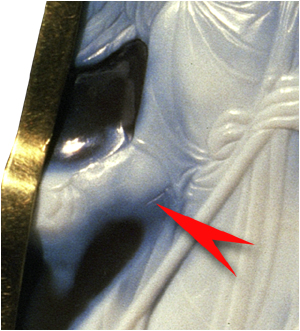
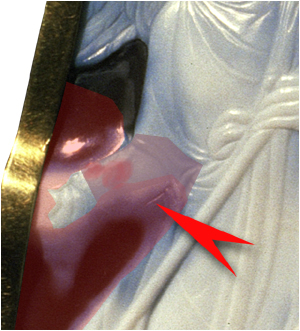
Remains of the original arm, running almost parallel to the sceptre, still visible above the arrow.
The reworked areas are highlighted in red.
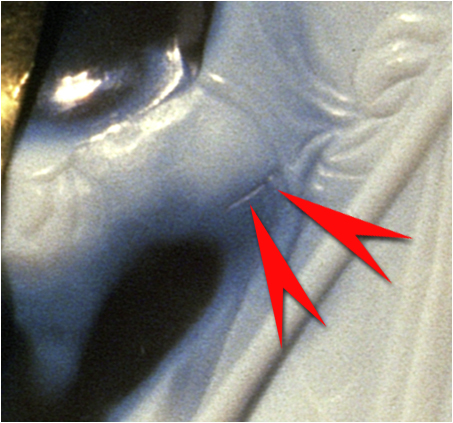
The sharp cut defining the lower edge of the lower arm is in between the reworked incisions and thus secondary.
The position and notably the height of the secondary lower arm (B) — the original lower arm was higher — makes it improbable that the rising folds of the slightly lower positioned togatus next to Tiberius could have continued below the secondary reconstructed lower arm in a straight line (traces of the folds can be seen to the left of the sceptre (A)). The drapery would collide with the lower arm now visible and thus the lower arm must have been newly shaped from the drapery of the togatus.
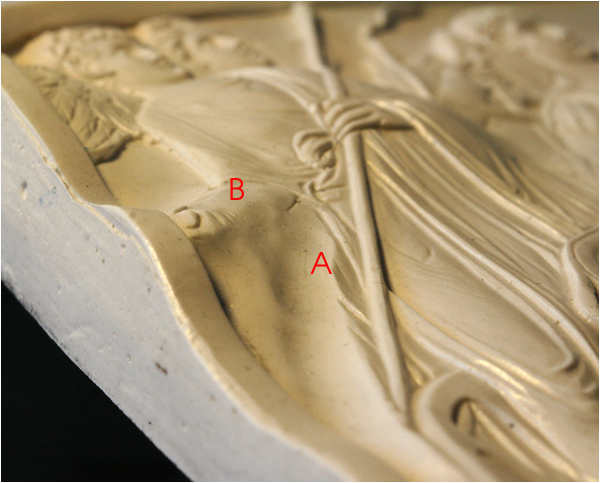
A: The rising folds
B: The secondary lower arm
The deep cut, parallel to the sceptre, is clearly visible. This section originally showed the the right arm of Tiberius.

(photographic reconstruction)
Tiberius with sceptre and laurel wreath
The lowered shoulder, crooked arm and the outstretched leg are three positions not easily combined. They do not correspond to any natural sequence of motion. The reworked section becomes evident.
The right arm, shown in the photographic reconstruction, in connection with the lowered shoulder and the stretched right leg, results in a harmonious picture.
Gerhard Schmidt
February 2010
<<< back to gemmarius-sculptor
(1) Caius Suetonius Tranquillus, The Twelve Caesars.
The deified Augustus 23.49
XXIII. In all his wars, he never received any signal or ignominious defeat, except twice in Germany, under his lieutenants Lollius and Varus. The former indeed had in it more of dishonour than disaster; but that of Varus threatened the security of the empire itself; three legions, with the commander, his lieutenants, and all the auxiliaries, being cut off. Upon receiving intelligence of this disaster, he gave orders for keeping a strict watch over the city, to prevent any public disturbance, and prolonged the appointments of the prefects in the provinces, that the allies might be kept in order by experience of persons to whom they were used. He made a vow to celebrate the great games in honour of Jupiter Optimus Maximus, ‘if he would be pleased to restore the state to more prosperous circumstances.’ This had formerly been resorted to in the Cimbrian and Marsian wars. In short, we are informed that he was in such consternation at this event, that he let the hair of his head and beard grow for several months, and sometimes knocked his head against the door-posts, crying out, ‘O, Quintilius Varus! Give me back my legions!’ And (87) ever after, he observed the anniversary of this calamity, as a day of sorrow and mourning. (...)
49.
XLIX. With respect to the army, he distributed the legions and auxiliary troops throughout the several provinces (...)A certain number of the forces were selected, to occupy the posts in the city, and partly for his own body-guard; but he dismissed (...) the Germans, whom he had amongst his guards, until the defeat of Varus. (...)
17.
Cui gloriae [sc. l.: Ac perseuerantiae grande pretium tulit, toto Illyrico (...)] amplior adhuc ex oportunitate cumulus accessit. Nam sub id fere tempus Quintilius Varus cum tribus legionibus in Germania periit, nemine dubitante quin uictores Germani iuncturi se Pannoniis fuerint, nisi debellatum prius Illyricum esset. Quas ob res triumphus ei decretus est multi[que] et magni honores. (...) Triumphum ipse distulit maesta ciuitate clade Variana; (...)
The English translation:
Caius Suetonius Tranquillus, The Twelve Caesars.
Tiberius 17-18
XVII. The glory he acquired by these successes [the defeat of Illyrica] received an increase from the conjuncture in which they happened. For almost about that very time Quintilius Varus was cut off with three legions in Germany; and it was generally believed that the victorious Germans would have joined the Pannonians, had not the war of Illyricum been previously concluded. A triumph, therefore, besides many other great honours, was decreed him. (...)He postponed his triumph, because the state was at that time under great affliction for the disaster of Varus and his army. (...)
(2a)On coins with similar depictions the star can be replaced with the Musnad horizontal sign for ‘shin’, symbol of the Semitic sun god. It is, therefore, possible to identify the eight pointed star as the sun.
It is not clear whether these small additional symbols are meant to denote the city in which the coin was struck.
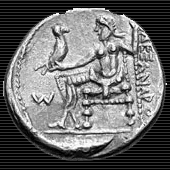
Tetradrachm
on the left the horizontal symbol "shin".
On the right the name of Alexander the Great
in Greek capital letters "AΛEΞANΔPOY" (Alexander in the genitive case: Alexandrou)
(220–200 BC)
(2b)Paul Zanker, Augustus und die Macht der Bilder. München 2003. S.57
(2c)The star behind the capricorn is not the comet Caesar (sidus Iulium). The flame is missing and the point of its ray is not vertical.
The comet appeared in 44 BC for seven days in the north-east.
see also:
Helmut Prückner
FS Lorenz
Vienna 1997. p.121
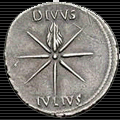
sidus Iulium or Caesaris astrum
(2d)Capricorn and Scorpio are depicted on the Gemma Augustea. Capricorn is well documented to be the birth sign of Augustus.
The assumption that the sign of Scorpio on the pelta at the tropaion in the lower register of the Gemma Augustea is the birth sign of Tiberius cannot be attested.
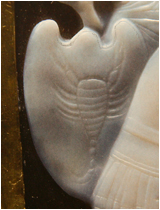
______
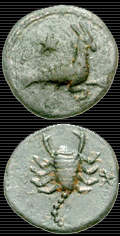
On this coin Capricorn and scorpion are shown together. Therefore a connection between the two signs of the zodiac must have existed. The nature of the connection does not emerge: none of these coins are inscribed.
Photo: © CNG
(3)
E. Zwierlein-Diehl,
Magie der Steine, Kunsthistorisches Museum,
Vienna 2008, p.268.
(3a)Hugo Meyer: Prunkkameen und Staatsdenkmäler römischer Kaiser. Neue Perspektiven zur Kunst der frühen Prinzipatszeit,
München 2000, p 61.
(A) Fernand de Mely,
Le Camayeul de Saint-Sernin p.72:
In sacristania alta est quedam capsa
parva fustis noguerii que clauditur cum tribus clavibus. Quidam pulcher et multum dives et pretiosus
lapis, vocatus vulgariter Camaliel appositus et compositus supra lapidem vulgariter dictum casideone
et est inclaustratus in argento.
Et a parte retro sunt due ense ad deferendum eundem. Et a parte ante et de subtus a latere dextro est quidarn lapis albus sub colore cristalli, longus, modicum inclaustratus et a latere sinistro quidam lapis niger quasi quadratus et desuper a parte dextra quidam lapis
diversarum quadraturarum rubeus sub colore safrani.
Et a parte sinistra de superiori historia est figura quadrige, et ab alia parte, quidam lapis quasi rotundus, vulgariter dictus cassidoine et de super in dicto lapide Camasuelis et superiori historia sunt decern personatgia in dicta historia et quedam aquila in pede illorum, quasi circa medium a latere dextro: et in inferiori historia sunt undecim personatgia; que quidem lapis est unius palmae cane amplitudinis et quasi unius altitudinis, et dictus lapis est fractus in medio, videlicet in secunda historia ad longum.
The German translation:
In der hohen, oberen Sakristei befindet sich eine gewisse kleine Kapsel aus Nussbaum
(fustis noguerii) , die mit drei Schlüsseln verschlossen wird. Ein wahrhaft schöner, sehr kostbarer und prächtiger Stein, gemeinhin Camaliel [ Kameo] genannt, der oberhalb eines Steines – gewöhnlich Cassideone
[ Calcedon] genannt – gesetzt und in Silber gefasst ist.
Auf der Rückseite befinden sich zwei Schwerter
[ Griffe ? ], mit denen man ihn gehend wegtragen kann. Auf der Vorderseite und auf der rechten Seite unten befindet sich ein gewisser weißer Stein von kristallener Farbe, lang, bescheiden eingefasst und auf der linken Seite irgendein schwarzer, fast quadratischer Stein, darüber auf der linken Seite irgendein roter Stein in verschiedenen Vierecken von safrangelber Farbe.
Und auf der linken Seite des obigen Darstellung befindet sich die Figur einer Quadriga und auf der anderen Seite ein gewisser fast runder Stein, gewöhnlich Cassidoine genannt und darüber auf dem Camasuelis genannten Stein und auf der obigen Darstellung sind zehn Personen und irgendein Adler zu ihren Füßen; gleichsam etwa in der Mitte der rechten Seite und auf der unteren Darstellung sind elf Personen; und zwar ist dieser gewisse Stein eine Handfläche breit und eine hoch und der besagte Stein ist in der Mitte gebrochen, nämlich in der zweiten Darstellung der Länge nach.
(3b) Only the Capricorns link the picture to Octavian.
(4)
Helmut Prückner
FS Lorenz
Wien 1997.
Peter Scherrer
ÖJh 58
Wien 1988.
(4a)
In accordance with Augustus’ instruction Agrippina Maior was married in 5 AD to Germanicus , the nephew and adopted son of Tiberius. Agrippina Maior was the daughter of Augustus` friend Marcus Vipsanius Agrippa and Julia, daughter of the emperor — an additional move to secure the succession.
(5)
Ernst Künzl
Der römische Triumph
München 1988
Peter Paul Rubens
(1577-1640) was born on the 28th of June 1577, the son of Jan Rubens and Maria Pypelincks in Siegen. After the death of the father in 1587 the family (Rubens had six siblings) moved to Antwerp. In 1600 he travelled to Italy, where he lived and worked for eight years, mainly in Mantua and Rome. It was here that Rubens, one of the most famous painters of the Baroque for his altar pieces, started to collect portraits and paintings with mythological scenes and antique gems. In 1626 he sold 196 pieces from his collection to the Duke of Buckingham. One of his best pieces, Tryphon’s cameo of Amor und Psyche, was left to his son Alfred, who in 1665 wrote a treatise on the Gemma Augustea.
